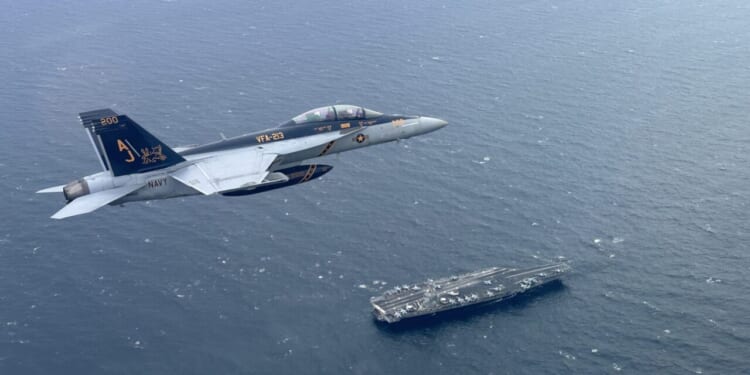The Navy intends for the sixth-generation F/A-XX to replace the aging F/A-18 and E/A-18 aircraft.
Defense Secretary Pete Hegseth has reportedly approved plans to advance the Navy’s F/A-XX sixth-generation stealth fighter program by selecting a primary contractor. That announcement could happen as early as this week. Northrop Grumman and Boeing are vying for the contract after Lockheed Martin dropped out of the competition earlier this year.
Hegseth’s approval came last Friday, with sources indicating that a decision is imminent. That speculation gained strength with President Donald Trump’s weekend visit to the aircraft carrier George H.W. Bush, where he observed flight operations with Chief of Naval Operations Admiral Daryl Caudle. Trump’s visit was in observance of the US Navy’s 250th birthday, an auspicious time to announce a major initiative like the F/A-XX.
The Navy’s F/A-XX Fighter
The Navy has been calling for the development of a sixth-generation fighter, dubbed the F/A-XX, to replace the aging fourth-generation F/A-18 Super Hornet and E/A-18 Growler aircraft. The new aircraft would serve alongside the Lockheed Martin F-35 fifth-generation fighter and a planned Collaborative Combat Aircraft (CCA), which has yet to be decided upon. CCAs are unmanned craft controlled by manned fighters like the F/A-XX.
The F/A-XX project was reportedly in limbo earlier this year, though Boeing disputed that notion. Rather, it appears that the Pentagon’s 2026 proposed budget deliberately underfunded the F/A-XX so as to not create a competition for resources between that aircraft and the Air Force’s new F-47 sixth-generation fighter. Military officials questioned the American industrial base’s ability to work on both projects simultaneously.
Tellingly, the Senate Appropriation Committee approved $1.4 billion for the F/A-XX program, effectively overriding the Pentagon’s plan to shelve the project over costs, despite the Navy’s objections.
Initial development was funded, and it appears the Pentagon is now ready to select a contractor. Boeing won the F-47 contract, so the F/A-XX contract would be a major coup for a company mired in criticism and doubt on its commercial aviation side. Northrop Grumman dropped out of the F-47 competition to concentrate on the F/A-XX and B-21 Raider projects, winning the latter contract. The company has not produced a fighter aircraft since the famed F-14 Tomcat series.
Challenges from China
The Navy has contended for some time that the F/A-XX is a necessary component of its future carrier aviation plans. China is outpacing the United States in fifth-generation fighter production, including the new Shenyang J-35, which achieved catapult-assisted takeoff but assisted recovery (CATOBAR) certification on September 22. The certification marked the new Chinese aircraft carrier Fujian’s initial full-deck operational capability. The first two Chinese carriers employ the ramped deck method for launching aircraft. The Fujian is the first to be equipped with catapults like American carriers. The US Navy has yet to launch a fifth-generation F-35 by catapult and is not expected to for at least a year.
Reports indicate that the J-35 has entered limited service production, and initial examples may already be deployed to the fleet. The J-35 is the carrier-based variant of the FC-31/J-31 family, distinct from the land-based J-35A used by the Chinese Air Force. It also possesses short takeoff and landing (STOL) capabilities, which have been demonstrated on the carrier Shandong.
China is also reportedly developing sixth-generation stealth fighters and accompanying CCAs. Given China’s robust maritime expansion, those efforts will certainly yield a naval variant. The United States must keep pace, and the F/A-XX and F-47 projects reflect that necessity.
President Donald Trump not only watched air operations but was also treated to a firepower demonstration and met with senior Navy officials. Caudle himself was wearing a flight suit, which may have been a not-so-subtle hint, given his past advocacy for the F/A-XX.
Whether those efforts have paid off remains to be seen. The Pentagon has seemed on the cusp of advancing the F/A-XX before, but last-minute problems have always delayed the move. That could certainly happen again, but all indicators point to the F/A-XX finally getting the green light.
About the Author: William Lawson
William Lawson is a military historian focusing on World War II and 20th century conflicts and the American Civil War. His specialty is operational level warfare, especially American amphibious doctrine. He writes on history, politics, and firearms for multiple publications and historical journals. He serves on the editorial advisory board for the Saber & Scroll Journal and Military History Chronicles and is a member of the Society for Military History and the American Historical Association. Lawson is based in Virginia.
Image: DVIDS.


















